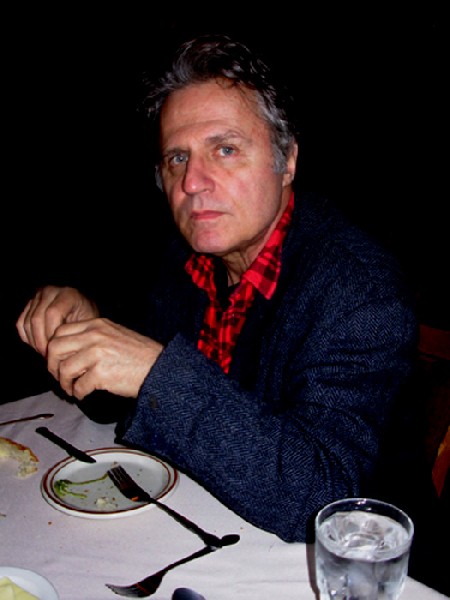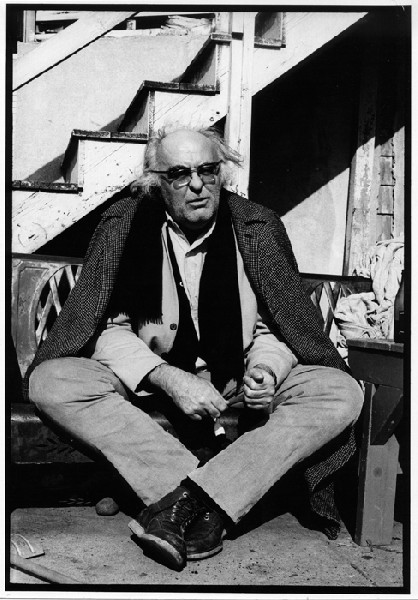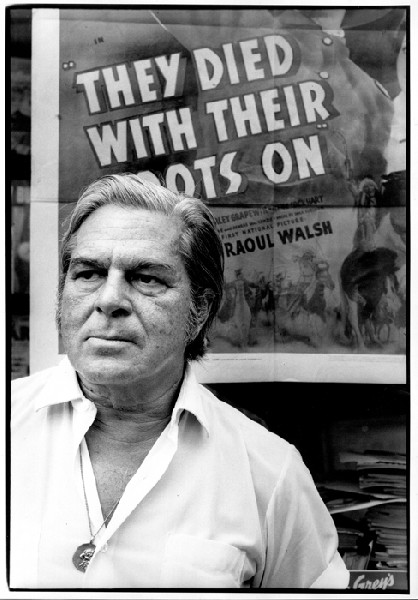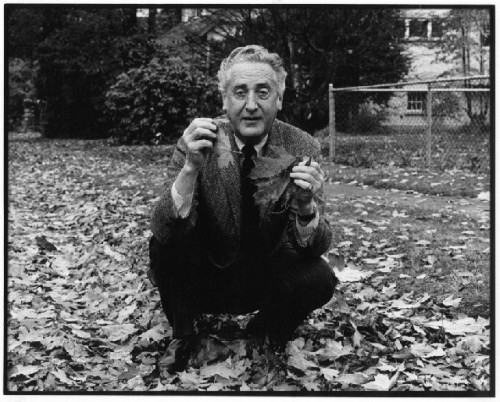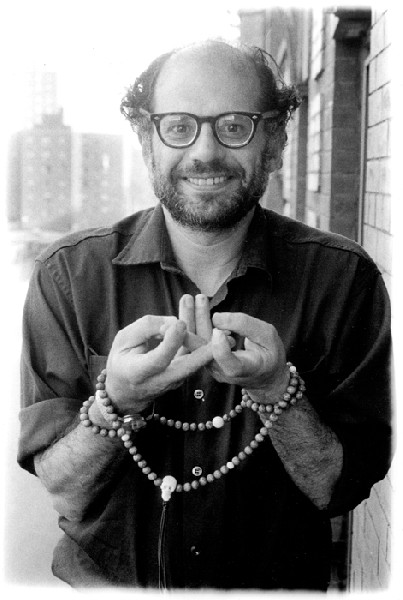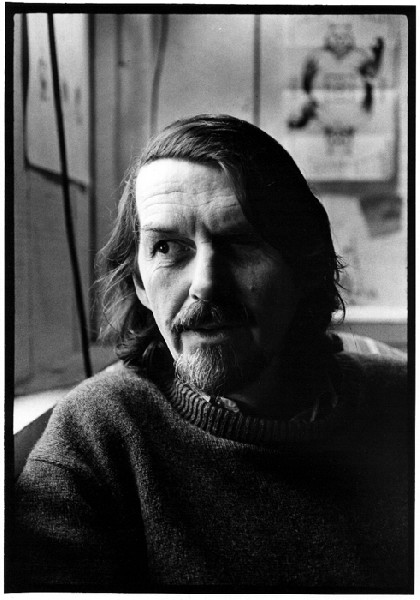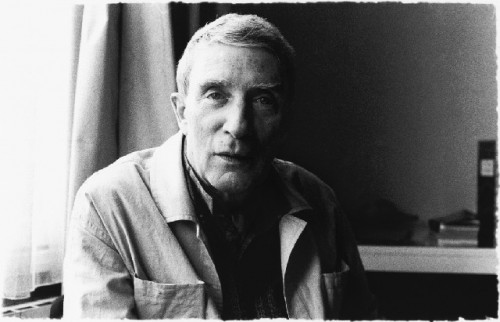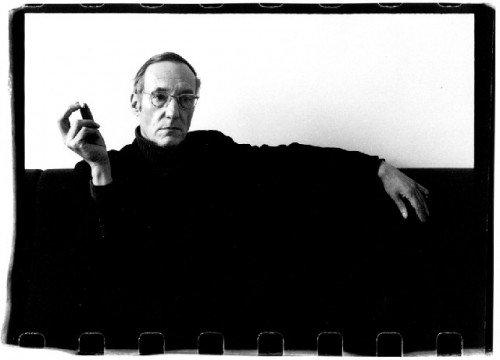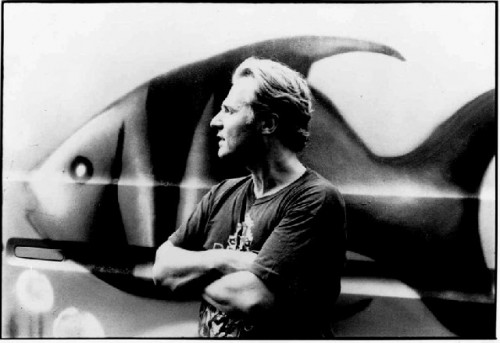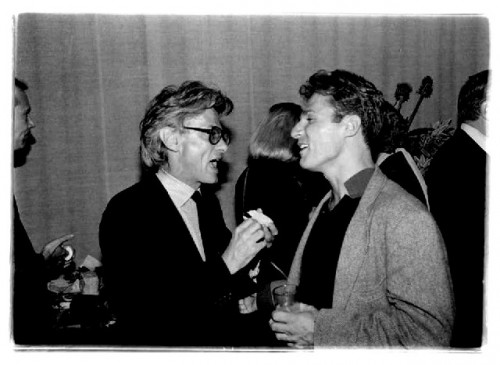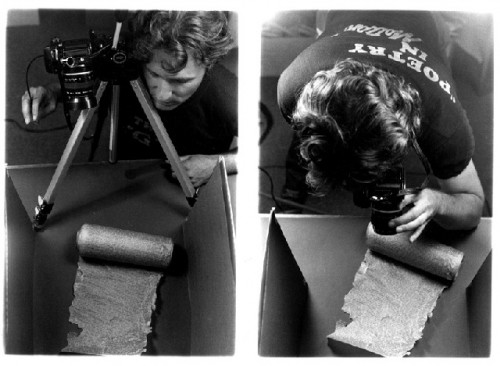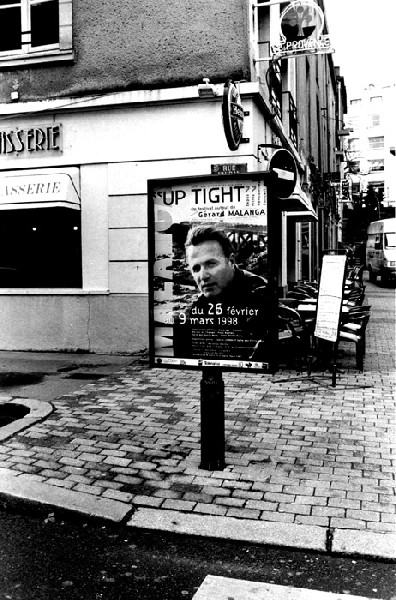Gerard Malanga Interview Part Three
A Touch of the Poets
By: Gerard Malanga and Charles Giuliano - Mar 30, 2010
Gerard Malanga
Souls
Pierre Menard Gallery
10 Arrow Street
Cambridge, Mass. 02138
March 12 to April 12, 2010
Archives Malanga
CHARLES GIULIANO In past conversations you discussed visiting with Charles Olson in Gloucester. And also mentioned being close to Robert Creeley. Could you discuss those relationships as well as other poets you were close to? You took some iconic images of William Burroughs which I published in Nightfall Magazine ages ago. In fact I bought one of the images. Of him standing in front of the Burroughs company logo. How well did you know him and Ginsberg? How about the other Beats like Gregoy Corso who lived at the Chelsea?
GERARD MALANGA Bob (Creeley) and I span nearly forty years together and I've recounted all this in a long piece published in the Academy of American Poets newsletter back in '05. Allen was also a dear friend known since early '64 who always seemed to wanna look after me. We even shared two apartments on the top floor of this six-storey walk-up on East 5th Street way over by Avenue D, so we go back a long way over many adventures.
He commissioned me to photograph Jack Kerouac's "roll manuscript" as he liked to call it of On the Road back in '82. I was the first photographer ever to set eyes on that manuscript. Bill I'd met at a party at Pana Grady's apartment over at the Dakota. This would've been in '67. She was a patron of some of the Beat poets, so there was a lot of money flying around. Bill somehow knew I was in correspondence with Donatella Manganotti, his first Italian translator, and urged me to look her up once I got over to Italy. Then I didn't see Bill again until that trip Jim, Irene and I made to London back in '72.
It was bitter cold as I recall. February. I photographed him with Brion Gysin at their fancy flat over in St. James's. So we became instant friends. Bill adored my cat Eban whenever he'd visit the flat Diane Hersey and I had over on East 14th. You remember it.
Gregory and I never got along. He was always trying to compete with me because of this Italian-American connection he had going. There's nothing I dislike more than a cornball. He always made a big deal about being an ex-con when really he was just a juvenile delinquent from reform school. But Bob, Allen, Bill were all lifelong friends from the start.
CG: What about Charles Olson? You have mentioned to me in the past the impact of meeting him. Can you describe the encounter and his importance to you as a fellow poet? Did you see him on more than one occasion? It took quite an effort to get to Gloucester and I assume he was elderly.
GM: Nothing of the sort. He was not elderly when we met. He was 59 years-old; eight years younger than I am now. It was serendipitous how I came to meet him at all. Sometime in winter '69 I ran into Peter Ardery, George Plimpton's Boy Friday, at Max's Kansas City during Happy Hour. That's where us poor poets got the free plate. Peter whom I got along with very well was expressing his frustration to me at trying to get Olson to be interviewed for The Paris Review and not getting an answer. So I said that I was the man for the job. I can get him to respond.
Now I'd never met Olson, so I had no idea if he even heard of me. Well, my reputation preceded me in the poetry world which was far smaller than it is now. As I later learned, the mere mention of my name got a rise out of him. I wrote him and he immediately responded, saying something like Come immediately! as if we were meeting for a duel.
George was thrilled with the idea of having me interview Olson. Come springtime, it was all arranged and I flew up on the Boston Shuttle and guess who's on the flight but George heading over to some Harvard sports event and he wanted to hand me some extra cash but I politely refused. He'd been generous enough as it is.
Upon arriving in Boston I caught this commuter train up to Swampscott and was met by Gerrit Lansing, a poet and close friend of Charles and stayed overnight at his place and the following day we met up with Harvey Brown, a former student of Olson's when he was teaching at SUNY-Buffalo; and we went out to lunch and walked the pebbled beach over to Gloucester where Olson was waiting for me like some big cross-legged Buddha ready to pounce and grabbed me in a bear hug that I literally felt I was disappearing in the arms of this 6' 7" hulk and then I made the photo of him which became world-famous. My first serious portrait and the first of my three iconic shots.
I also shot a roll of 16mm color film and after hanging out a spell in the backyard the four of us headed up the stairs to Olson's flat and talked and taped the night away. I fell out way before Olson.
The next morning it was just me waking up and Charles in the backroom asleep. The second and last time I spent with him was when Bob Creeley and I visited him at New York Hospital in January 1970. He was diagnosed with a terminal liver cancer, but was in terrific spirit proselytizing about how his illness was connected to the Prometheus myth of an eagle pecking at his liver and dancing around the room in his bathrobe, cracking jokes with the nurses and reading from his poetry to Bob and me as we sat entranced. A company of three. When we departed towards the end of the day it would be the last time either of us would see him. He passed away about a week later.
He was a giant among giants and a legend in his own time and when he read his poetry it was like a maelstrom was tearing through the room and I know he appreciated me because I represented for him the antithesis of the glamour that he discovered was not representative of me and which he could poke fun at and we had a good laugh. He took me in and made me feel at home in his presence. He was 60.
CG: You get a number of gigs to present Warhol material and discuss his legacy. Often this entails screening films. Just what do you have of the archival material? What do you usually show on those occasions? You have mentioned issues with the Warhol Museum. Just what is your relationship with the museum? Have they ever involved you in any of their official and archival activities? We visited a couple of years ago and it felt very raw. It seemed as though they were trying to be like the Factory.
GM: I've structured this programme so it runs pretty smoothly and everyone gets to participate. I put together this new film in 2005 of archival footage Barbara Rubin and I shot back in the '60s and it had its world premiere at the Vienna Film Festival, the second largest festival in Europe after Cannes. Jane Birkin and I were the honorees that year. I had 6 films in three separate programmes and did two weeks worth of press interviews until I was tongue-tied.
Anyway, what I do now is screen this movie which is called Gerard Malanga's Film Notebooks at special Warhol events or even at events that having nothing to do with Warhol. The film contains footage of Bob Dylan and Donovan and Salvador Dali visiting the Factory; the Velvets performing at the opening of Paraphernalia boutique; the Olson footage; Jack Smith reading Batman comics. The soundtrack throughout is by Angus MacLise. The movie runs comfortably at 27 minutes. Then there's a 5 minute break and I read my poetry for 30 minutes or so and then we open it up to a Q&A with the audience.
It really works and is fairly easy to set up. I can honestly say that I don't have a relationship with the Warhol Museum. They feel that they're the custodians of Andy's legacy but their attitude from the start is that there's no room for Gerard in that legacy. It's the old Cinderella syndrome. Know thy place. OK. Two can play the game. They never involved me with any events at the museum. So be it.
The Beinecke has embraced my work. I visited the museum back in, when was it, the weekend John Kennedy Jr. was killed in the plane crash. A friend, Hennie Waroux, a Belgian journalist, invited me to illustrate the diary she was keeping of the visits we made to every known habitat that Andy was associated with, both in Pittsburgh and New York. We got to see a lot.
It was a hellish heat wave that struck Pittsburgh that Sunday. It's lucky we had a car and driver. Every time I got out to take a few shots I scurried back to the car's AC comfort. We finally ended the day by visiting the Warhol Museum where I managed to take some shots of the floating silver pillows and Hennie and I commemorated the visit with a photobooth portrait and a bite to eat at the restaurant. It wasn't until the very last minute when departing that an intern recognized me, so I turned to Hennie and said, You watch; tomorrow morning the museum will be buzzing. I never looked back.
CG Over the years you have been working on your memoirs. It seems that there is a cottage industry of books by surviving members of the Warhol circle. And of course the wonderful "Edie" by George Plimpton which is fascinating. When might we anticipate the publication of the Malanga papers? By the way, what ever became of the whip and leather pants? They belong in a museum.
GM: The whip and the leather pants, I'm afraid, went the way of all flesh! In fact, a friend once came up with this idea that maybe we should market a limited signed/numbered edition of the whip packaged in a mahogany box lined in blue velvet with a glass front. Well, that's a bit much. I'm not into the nostalgia business and right now I simply don't have the time to sit and write my memoirs.
About twenty years ago I did sketch out several chapters with the title, Memory in Progress, but somewhere along the way I got distracted and went on to something else. Friends and strangers alike keep asking me, "When are you going to write your memoirs?" but I haven't the answer right now. I'm sure there's a story to tell, but not without a publisher to back me up, the enormity of the project is not something I want to do on my own.
CG The first time I saw you was a debauched, gonzo night when Rene Ricard took me to the Balloon Farm in St. Mark's Place which was formerly The Dom and originally a Polish Social Club. You were a part of Warhol's road show the Exploding Plastic Inevitable with Lou Reed, Nico and the Velvet Underground. That night you did your whip dance. I don't recall if you had a shirt on.
Later we met at Benno's in the Berkshires. That first night Don Snyder photographed us wearing several neckties. I would love to see that image. Through the years it seems that the whips and leathers Warhol persona has been a blessing and curse. It opened doors but also type cast you. The artist and friend I have known and appreciated over the years is so much more than those first impressions. What does it mean to look back on that era now as a man in his 60s? I saw Lou recently and he seemed more like an embalmed rocker. Give me your riff on faded glory and the Portrait of Dorian Grey.
GM: You know, I have that photo of us trying on ties side by side in the -- what was it called? -- The Birdhouse? Don made a print for me. It's somewhere here in the archives.
Yes, that Warhol type-casting has been a blessing and a curse. Rather, it's opened doors but it's also closed them, especially in the poetry world. But I don't let it get to me. I remember reading somewhere some statistic that says that we humans move seven or eight times in our life. Well, I think I've got one more move in me. Where will it be?
But for now, the move I made is a good one. I'm more secure in my surroundings and am blessed with the solitude that I've so longed for. The only time I even think of those first impressions from forty-five years ago is, like right now talking to you.
I get to do interviews from time to time, so inevitably the dialogue keeps coming back to the '60s and my involvement with Warhol. Otherwise, I'm too busy with the present to even dwell on the past. I get up at 6 in the morning to feed my cats. I go out to get the NY Times at the grocer round the corner. I sit and have a breakfast tea and a slice of bread with jam while reading the paper and sometimes scribbling a poem across the page.
I have a flat-file Asako and I picked up for a song in Woodstock --excuse the pun -- and I use it as a worktable. While working I listen to my many classical LPs. Dvorak, Ives, Milhaud, MacDowell, Mussorgsky, Saint-Saens, Griffes, Howard Hanson and anything he's conducted. It gives me a sense of optimism whenever I sit and listen and write.
Some days I do chores around the house; on others I do errands like going to the bank or the post office. That's about as busy as it gets; or I read a lot. So you see, I don't look back.
As Bob Creeley once said; "We live as we can, each day another--there is no use in counting." And then the sun goes down.

